About five years ago, I tasked myself with the seemingly minor endeavor to choose my favorite books from the past year and write a blog post about them. Since then, I have felt obligated to write such a list every year, and over time, the rules have gradually gotten more specific and the lists have gotten a little longer. That’s just how I do things.
So here’s how this works: I’ve classified these books into eight different categories depending upon format and reading level. (These are all books for children and teens; I don’t read enough grown-up books to include those.) Within each category, I’ve picked 3-7 of my personal favorites that were published during 2019. The picture book category and the middle-grade novel category also get a second list of runners-up just because there are so many great books. It’s too hard to pick just seven. Any of those books that I’ve previously reviewed or mentioned on this blog is hyperlinked back to that previous post. Unlike certain official awards like the Caldecott and Newbery, my list can include books from other countries, although I think all of my favorites this year are American.
To be fair, I probably should acknowledge that this list is based entirely on my personal opinion. It will inevitably reflect my tastes in picture book art, my personal interests in non-fiction topics, and my genre preferences. (This year, I’ve noticed that a lot of my favorite books have similar plotlines in which the protagonist discovers deep, dark family secrets.) Also, I can only include books that I actually read in their entirety, which obviously limits things a little. (I haven’t quite finished With the Fire on High, which might or might not have made my list in the YA category if I had finished reading it by now) With those caveats acknowledged, here are the 53 books from this year that I liked and would like to recommend.
Picture Books:
Camp Tiger by Susan Choi, illustrated by John Rocco
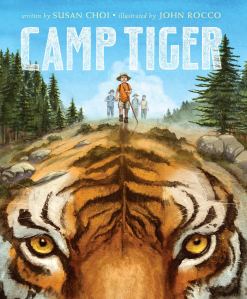 This book is geared for an older target audience than most picture books are; I’d recommend it for second and third graders. (Or for unusually precocious kindergartners and first graders) The narrator himself is only just about to start first grade, but the plot is complex and potentially confusing. In this case, I feel like that’s a positive thing, because it’s a thought-provoking and interesting story. The protagonist encounters a tiger on his family’s camping trip, but it’s unclear whether we’re supposed to take the tiger literally. Perhaps it’s a dream, or maybe it’s all in his imagination. The potential explanation that I’ve decided I like best is that the “tiger” is actually a cat. It’s really there, but only in the boy’s imagination is it a tiger. (I get the vague sense that this book is at least partially influenced by the Calvin & Hobbes comics) Whichever way you interpret it, this is a sentimental story about the transition from early childhood to being a big kid. All of this is set against gorgeous scenery that, in my opinion, is already enough to make this book stand out as an especially notable picture book.
This book is geared for an older target audience than most picture books are; I’d recommend it for second and third graders. (Or for unusually precocious kindergartners and first graders) The narrator himself is only just about to start first grade, but the plot is complex and potentially confusing. In this case, I feel like that’s a positive thing, because it’s a thought-provoking and interesting story. The protagonist encounters a tiger on his family’s camping trip, but it’s unclear whether we’re supposed to take the tiger literally. Perhaps it’s a dream, or maybe it’s all in his imagination. The potential explanation that I’ve decided I like best is that the “tiger” is actually a cat. It’s really there, but only in the boy’s imagination is it a tiger. (I get the vague sense that this book is at least partially influenced by the Calvin & Hobbes comics) Whichever way you interpret it, this is a sentimental story about the transition from early childhood to being a big kid. All of this is set against gorgeous scenery that, in my opinion, is already enough to make this book stand out as an especially notable picture book.
If I Was the Sunshine by Julie Fogliano and Loren Long
There aren’t a lot of words in this book, and those few words are very repetitive, but it’s actually pretty intellectual given that its target audience is preschoolers. I recommend reading it with a child one-on-one; read slowly and give the child moments to pause and think about what the story is saying. Each phrase examines the connection between two things, (such as the sunshine and the day, or the winter and the spring) by having them give a nickname to each other. For example, the sunshine calls the day “hello” and the day calls the sunshine “stay”. Of course, it’s phrased in such a way that it rhymes. The story requires and encourages some analytical thought. Like several of my other favorite picture books from this year, it’s a story that will build a young reader’s cognitive and comprehension skills. In addition to that benefit, this book also has strong appeal factors because of its nature theme, its feel-good “you and I” language, and the fact that it ends up being a bedtime story. As a side note, the variety of perspectives in the artwork is a nice touch. Some of the pictures are very close-up, such as the ones with the worm and the apple, while others depict an entire landscape.
Field Trip to the Moon by John Hare
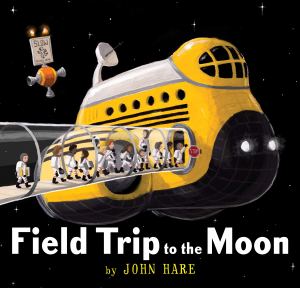 This wordless sci-fi picture book shows a class of spacesuit-clad students exploring the surface of the moon, then accidentally leaving one child behind. Before eventually being rescued, she befriends a group of aliens and shares her crayons with them. None of the other people from Earth ever see the aliens, and in fact, the protagonist gets blamed for drawing on the moon rocks, when it was in fact the aliens who did it. It seems to be implied that the aliens don’t speak in a human language and have no way of communicating with the girl, but they bond over the experience of creating art together. While that might not be a completely original concept, it’s generally not one that you’d find in a book with such a young target audience. I felt that the wordless-picture-book format was a poignant way to express the idea and that the science fiction setting gives the story a distinctive tone. Even the use of the quiet-kid-in-school trope doesn’t feel like a cliche in this setting. I’d recommend this book for kids in kindergarten through second grade. But obviously, since it has no words, that has nothing to do with reading level; I’m basing that entirely upon its subject matter.
This wordless sci-fi picture book shows a class of spacesuit-clad students exploring the surface of the moon, then accidentally leaving one child behind. Before eventually being rescued, she befriends a group of aliens and shares her crayons with them. None of the other people from Earth ever see the aliens, and in fact, the protagonist gets blamed for drawing on the moon rocks, when it was in fact the aliens who did it. It seems to be implied that the aliens don’t speak in a human language and have no way of communicating with the girl, but they bond over the experience of creating art together. While that might not be a completely original concept, it’s generally not one that you’d find in a book with such a young target audience. I felt that the wordless-picture-book format was a poignant way to express the idea and that the science fiction setting gives the story a distinctive tone. Even the use of the quiet-kid-in-school trope doesn’t feel like a cliche in this setting. I’d recommend this book for kids in kindergarten through second grade. But obviously, since it has no words, that has nothing to do with reading level; I’m basing that entirely upon its subject matter.
Trees by Verlie Hutchens, illustrated by Jing Jing Tsong
Most of the promotion and reviews for this book classify it as a collection of poems, but in my opinion, it’s best read as one continuous piece. Each double-page spread depicts a different type of tree, describing it with anthropomorphic language to point out that the individual trees have distinct personalities. The illustrations of the trees, however, are more literal and realistic. In some cases, there’s also a person somewhere in the picture who fits the description given in the text and embodies the same personality as the tree. This is perhaps most obvious on the page that describes the Sycamore as a fashion queen. The woman sitting on a bench beneath the tree is dressed just as the words say, even though those words are talking about the tree. Still, the trees are always the focal point of the illustrations and they always take up the majority of the page. On the one hand, this book can be used as a fun and playful introduction to the concept of metaphors, but on the other hand, it can simply be read as an ode to the natural beauty of trees, accompanied by a set of lovely illustrations.
A Big Bed for Little Snow by Grace Lin
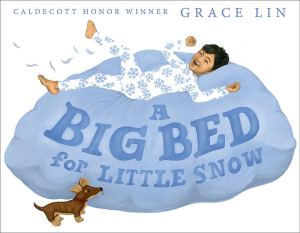 This is essentially a sequel to a 2018 book, A Big Mooncake for Little Star, which imagines that the phases of the moon are caused by a girl (who is actually a star) sneaking bites out of the moon when her mother isn’t looking. This new book takes a similar approach to explaining snow. Little Snow is a boy who jumps on his bed (which is a cloud) so much that the feathers (snowflakes) come out and fall to the ground below. Little Snow and his mother are illustrated as realistic-looking humans wearing white pajamas covered with blue snowflakes. The plot and the book’s layout are simple and straight-forward, which is perhaps the main reason that the metaphor holds up as well as it does, despite the fact that the target audience consists mainly of children who are too young for much narrative complexity. I think that what I love most about this book is that it has the potential to help preschoolers (and slightly older children) develop those kinds of comprehension skills. But Lin also deserves a shout out, and perhaps another Caldecott honor or award, for the beauty and elegant simplicity of her artwork.
This is essentially a sequel to a 2018 book, A Big Mooncake for Little Star, which imagines that the phases of the moon are caused by a girl (who is actually a star) sneaking bites out of the moon when her mother isn’t looking. This new book takes a similar approach to explaining snow. Little Snow is a boy who jumps on his bed (which is a cloud) so much that the feathers (snowflakes) come out and fall to the ground below. Little Snow and his mother are illustrated as realistic-looking humans wearing white pajamas covered with blue snowflakes. The plot and the book’s layout are simple and straight-forward, which is perhaps the main reason that the metaphor holds up as well as it does, despite the fact that the target audience consists mainly of children who are too young for much narrative complexity. I think that what I love most about this book is that it has the potential to help preschoolers (and slightly older children) develop those kinds of comprehension skills. But Lin also deserves a shout out, and perhaps another Caldecott honor or award, for the beauty and elegant simplicity of her artwork.
The Bell Rang by James Ransome
There aren’t a whole lot of historical fiction picture books out there, probably in part because they’re difficult to write well. How much contextual information can an author realistically fit into a picture book, and how much background knowledge can such a young reader be expected to have? This is probably the shortest and most concise book of its genre that is actually well-written. It’s impressive just how much information Ransome is able to convey about slavery and plantation life in antebellum America in so few words. Of course, the illustrations help. The artwork in this book is detailed and realistic, with an emphasis on the characters’ facial expressions and a mostly earth-toned color palette that serves to draw attention to the few brightly-colored things, such as the main character’s pink headscarf. Despite its difficult subject matter, this book is well-suited for readers as young as first grade or maybe even kindergarten. There isn’t a lot of text and the language isn’t complex; most kids of that age will be capable of reading it by themselves. Still, because of the topic, it would be helpful for parents or teachers to discuss the book with the child, especially for the sake of providing some contextual information.
Llama Destroys the World by Jonathan Stutzman, illustrated by Heather Fox
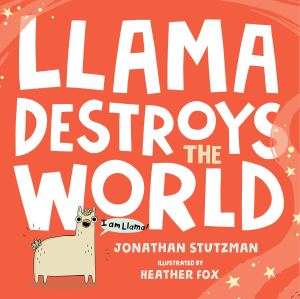 On Friday, Llama will destroy the world. So begins this goofy story that blends a science fiction concept, absurdist humor, and a cutesy, cartoonish aesthetic. Admittedly, it probably has more adult appeal than child appeal. Despite the bright, cheerful, child-friendly illustrations, the actual plot will go over the heads of most preschool-aged children. But as I wrote in my earlier blog post linked above, I think that there are some kids out there who will love it, and moreover, it’s always a positive thing when adults enjoy the books that they read to children. So, if nothing else, I highly recommend this book as something fun to have on hand at family gatherings to entertain relatives of all ages.
On Friday, Llama will destroy the world. So begins this goofy story that blends a science fiction concept, absurdist humor, and a cutesy, cartoonish aesthetic. Admittedly, it probably has more adult appeal than child appeal. Despite the bright, cheerful, child-friendly illustrations, the actual plot will go over the heads of most preschool-aged children. But as I wrote in my earlier blog post linked above, I think that there are some kids out there who will love it, and moreover, it’s always a positive thing when adults enjoy the books that they read to children. So, if nothing else, I highly recommend this book as something fun to have on hand at family gatherings to entertain relatives of all ages.
Other picture books:
Noah Builds an Ark by Kate Banks, illustrated by John Rocco
Bear is Awake: An Alphabet Story by Hannah E. Harrison
One Fox: A Counting Book Thriller by Kate Read
Small in the City by Sydney Smith
A Stone Sat Still by Brendan Wenzel
Because by Mo Willems, illustrated by Amber Ren
Readers:
Where Is Mommy? By Pat Cummings
Honestly, I never did find many early readers from 2019 that I thought was exceptionally good. I’ve picked these three as the best, but I’m not especially excited about any of them, and I feel like this one is probably the least interesting of the three. But it’s a nice, short, simple story that’s great for young readers who are still at the stage where they sometimes need to sound words out slowly and aren’t quite ready for stories with a plot that requires comprehension skills. It consists mostly of one-syllable words, although there are a couple longer words and a contraction. (That’s the word “isn’t”, which appears twice) Most sentences are four or five words, with a few that are six or seven words, and there are only a couple sentences per page. They’re printed in nice, large font and accompanied by full-page illustrations that add some details to the story. There isn’t much of a surprise ending; it turns out that Mommy is in the garden, but we’ve been able to see her through the windows at various points throughout the book.
Harold and Hog Pretend for Real by Dan Santat
This is part of the Elephant and Piggie Like Reading series, which is a spin-off of Mo Willems’ popular Elephant and Piggie series. Unlike the original series, this newer series is written by multiple authors, and each title features new characters and a new setting. (Elephant and Piggie do make appearances at the very beginning and end of each book) This particular story is about a different elephant and pig who are playing a game of pretend in which they act as Elephant and Piggie. But Harold the Elephant isn’t much like Gerald, the elephant from Elephant and Piggie. And Hog isn’t much like Piggie. This momentarily jeopardizes their game and even their friendship until they realize that they can simply switch places. So Harold the Elephant takes on the role of Piggie while Hog pretends to be Gerald. The humor is similar to the original Elephant and Piggie books, and it follows the same word-bubble format, so this book will appeal to the same kids who love the originals.
Make a Wish, Henry Bear by Liam Francis Walsh
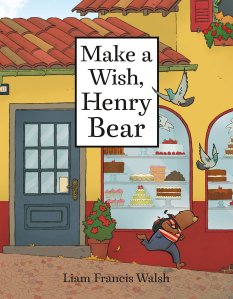 Henry Bear is tired of his parents’ antics. They always want him to stay up late when he’d rather sleep, they keep feeding him chocolate cake, and they try to get him to stay home from school to play with them. They even keep him from doing his homework because they need his help drawing on the walls. It is eventually revealed that this bizarre situation is the result of Henry Bear’s birthday wish last year. This year, he’ll have to use his birthday wish to set things right. This book is quite a bit longer than the previous two books I’ve described, and it has much more complex sentence structures and many multi-syllable words. The text is also arranged in paragraphs, although most of those paragraphs are pretty short because this story consists mostly of dialogue. It’s written at an advanced first-grade or early second-grade level.
Henry Bear is tired of his parents’ antics. They always want him to stay up late when he’d rather sleep, they keep feeding him chocolate cake, and they try to get him to stay home from school to play with them. They even keep him from doing his homework because they need his help drawing on the walls. It is eventually revealed that this bizarre situation is the result of Henry Bear’s birthday wish last year. This year, he’ll have to use his birthday wish to set things right. This book is quite a bit longer than the previous two books I’ve described, and it has much more complex sentence structures and many multi-syllable words. The text is also arranged in paragraphs, although most of those paragraphs are pretty short because this story consists mostly of dialogue. It’s written at an advanced first-grade or early second-grade level.
Chapter Books:
King & Kayla and the Case of Found Fred by Dori Hillestad Butler, illustrated by Nancy Meyers
The books in this series are on the line between readers and early chapter books, but they have enough text that I personally would classify them as chapter books. It’s a relatively new series, (the first couple books came out in 2017) about a child detective and her dog. They solve mundane, everyday mysteries, like finding missing dog treats, or, in this particular book, helping a lost dog find his family. Kayla’s logical problem-solving skills give this book the same appealing structure as a mystery for somewhat older readers. Her dog King adds humor to the story. He generally knows the answer to the question sooner than Kayla does and has to figure out how to communicate it to her. In this book, Kayla makes a list of things she knows (the dog she found doesn’t have a collar or any tags, but he is obviously a pet because he can sit, lie down, and shake hands on command) and things she doesn’t know, (where that dog came from and where his family is) while King simply talks to the dog. This is how we know that the dog’s name is Fred, and this his family is on a camping trip by the lake. This time, Kayla never does figure out the whole story, but King is able to lead Kayla and Fred back to Fred’s family.
The Dog Who Lost His Bark by Eoin Colfer, illustrated by P.J. Lynch
This is another one to recommend to animal lovers, although it’s longer and more challenging, and it’s sentimental instead of funny. Based on the reading level, I recommend it for kids around third grade, or a little younger if they’re avid readers who won’t be intimidated by the amount of text and the small font. It’s the story of a puppy who had previously been abused and his new human, a boy named Patrick who is gradually coming to the realization that his parents are separating. Patrick names the puppy Oz, which is a nod to his father who is currently in Australia. It takes a lot of determination and patience for Patrick to earn the puppy’s trust, but eventually, he discovers that music is the way to Oz’s heart. Patrick and Oz’s special connection seems to be broken when Patrick gets it into his head that his father might come back if he gets rid of Oz. (Patrick’s dad is allergic, which is why Patrick has never had a dog before) The rest of the story is predictable but satisfying and heartwarming. Oz is determined to cheer Patrick up and never gives up on his boy, even when Patrick tries to put Oz back in the shelter. Eventually, Mom and Oz together help Patrick come to terms with his family’s situation.
The Princess in Black and the Bathtime Battle by Shannon Hale and Dean Hale, illustrated by LeUyen Pham
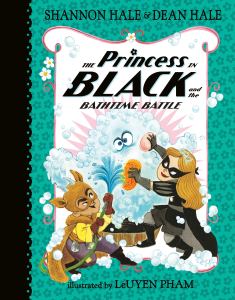 And now we’re back to a beginning chapter book that’s great for readers as young as first grade or maybe even kindergarten. In this seventh book of the series, our monster-fighting ninja-princess heroine follows a cloud of stench to the goat pasture. The Princess in Black and her friend the Goat Avenger can’t use their ninja moves against the smell, but they have some success in fanning it away. Unfortunately, in so doing, they accidentally blow the cloud of stench into neighboring kingdoms. The various princesses from those kingdoms each assume their own monster-fighting alter egos and join the Princess in Black in her task. The smell is coming from Monster Land, the entrance to which is in the goat pasture. When the other monsters kick out the stinky monster, it’s up to the Princess in Black and her friends to wage bathtime. (Waging bathtime involves the same ninja moves as waging battle, but it also requires soap and water) The Princess in Black books are always entertaining, and this one lives up to the high standard set by the early books. It is worth noting that the cast of recurring characters has grown a little too large for the newer books in the series to function as stand-alone stories. In order to fully appreciate this book, I recommend reading at least a couple of the others first.
And now we’re back to a beginning chapter book that’s great for readers as young as first grade or maybe even kindergarten. In this seventh book of the series, our monster-fighting ninja-princess heroine follows a cloud of stench to the goat pasture. The Princess in Black and her friend the Goat Avenger can’t use their ninja moves against the smell, but they have some success in fanning it away. Unfortunately, in so doing, they accidentally blow the cloud of stench into neighboring kingdoms. The various princesses from those kingdoms each assume their own monster-fighting alter egos and join the Princess in Black in her task. The smell is coming from Monster Land, the entrance to which is in the goat pasture. When the other monsters kick out the stinky monster, it’s up to the Princess in Black and her friends to wage bathtime. (Waging bathtime involves the same ninja moves as waging battle, but it also requires soap and water) The Princess in Black books are always entertaining, and this one lives up to the high standard set by the early books. It is worth noting that the cast of recurring characters has grown a little too large for the newer books in the series to function as stand-alone stories. In order to fully appreciate this book, I recommend reading at least a couple of the others first.
To the Future, Ben Franklin! By Mary Pope Osborne
2019 brought us two new books in the ongoing Magic Tree House series, and this is my favorite of the two. Jack and Annie travel to Philadelphia in 1787, tasked with helping “Doctor Ben make up his mind”. Doctor Ben is Benjamin Franklin, and the decision at hand is whether or not to sign the constitution. It’s a true historical fact that the writing of the constitution involved so much disagreement and compromise that many of the delegates were extremely dissatisfied with it. Real-life Benjamin Franklin wrote a speech urging all the delegates to sign it anyway. This book’s implication is that this speech was based on the conversations that “Doctor Ben” had with Jack and Annie. In order to convince him of the eventual success of the constitution, Jack and Annie make the unprecedented decision to bring Franklin back to Frog Creek, their modern-day hometown. But Franklin is understandably overwhelmed by all the unfamiliar sights and sounds, and the marvels of modern technology do little to persuade him. The turning point comes when Annie hits upon the idea of showing him the local public library. Benjamin Franklin is delighted to see this aspect of modern American culture. As a librarian myself, I’m admittedly a little biased towards stories that sing the praises of libraries. Personally, I think it’s fair to believe that Benjamin Franklin would indeed be pleased and encouraged at the knowledge that free public libraries would someday be a standard feature of American communities.
Graphic Novels:
Apocalypse Taco by Nathan Hale
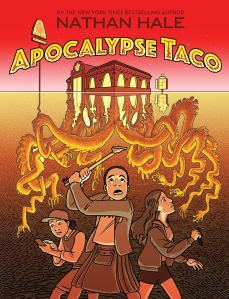 This bizarre science fiction graphic novel begins in a school auditorium as the cast and crew prepare the sets for tomorrow morning’s dress rehearsal of Brigadoon. The crew mostly consists of high schoolers, but eleven-year-old twins Axl and Ivan are part of the crew by default because their mother is the director. The pizza is gone long before the work is done, so their mother sends them out to get some fast food. Sid, one of the high schoolers, offers to drive. Unfortunately, the boys lose their McDonald’s vouchers. Rather than return empty-handed, they pick up some tacos. That’s when things get strange. First, the taco boxes come to life, and then after the kids escape and go back to the school, they find that it’s not quite as they left it. Everything, even the people, are made of a strange goop. It turns out that things are being taken over and replaced by strange creatures created in a college student’s bioengineering experiments. The story is crazy enough to feel unique and entertaining while still (sort of) making sense in a silly sci-fi/adventure kind of way.
This bizarre science fiction graphic novel begins in a school auditorium as the cast and crew prepare the sets for tomorrow morning’s dress rehearsal of Brigadoon. The crew mostly consists of high schoolers, but eleven-year-old twins Axl and Ivan are part of the crew by default because their mother is the director. The pizza is gone long before the work is done, so their mother sends them out to get some fast food. Sid, one of the high schoolers, offers to drive. Unfortunately, the boys lose their McDonald’s vouchers. Rather than return empty-handed, they pick up some tacos. That’s when things get strange. First, the taco boxes come to life, and then after the kids escape and go back to the school, they find that it’s not quite as they left it. Everything, even the people, are made of a strange goop. It turns out that things are being taken over and replaced by strange creatures created in a college student’s bioengineering experiments. The story is crazy enough to feel unique and entertaining while still (sort of) making sense in a silly sci-fi/adventure kind of way.
Best Friends by Shannon Hale and Leuyen Pham
Best Friends is a sequel to Real Friends from 2017 and it continues Shannon Hale’s autobiographical stories about her childhood social life. Now that she’s in sixth grade, Shannon feels that there are a lot of unspoken rules that she doesn’t quite understand. She starts the school year on a good note because she’s “best friends with the queen of the entire school,” but her social standing isn’t as secure as she’d like. Shannon’s friendship drama is the main story told in this book, but we also see Shannon experience symptoms of anxiety and OCD, and a fair amount of the book is dedicated to a story within a story as Shannon develops her creative writing skills. (She did, of course, grow up to be a successful writer. In case you didn’t catch this, this book comes from the same author and illustrator as the Princess in Black book listed above) The concluding author’s note reveals that these passages really did come from a story that she wrote as a sixth-grader.
Queen of the Sea by Dylan Meconis
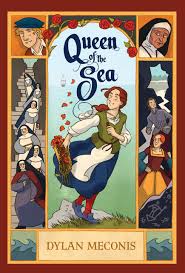 This graphic novel is set in the kingdom of Albion, which is essentially the same thing as Tudor England. Some of the characters correspond to specific people in English history, although the parallels only go so far; this is an original, fictional story. The main character is Margaret, a girl who has spent her entire life so far in a convent on a tiny island, mostly isolated from the rest of the world. Then Queen Eleanor loses the throne to her sister and ends up on that same island. Although Margaret and Eleanor don’t get along, they end up working together to plan Eleanor’s return to the throne. As it so happens, Margaret is Eleanor’s half-sister who was hidden away as a baby in order to protect her from her sisters and their feud over the crown. The political intrigue makes for an interesting story, and anyone with an interest in European history will enjoy comparing and contrasting this book with the events of actual Tudor England. In general, I’d recommend it for the younger side of the YA age range, (that is, middle school) but there will be a lot of somewhat younger readers who will also enjoy it.
This graphic novel is set in the kingdom of Albion, which is essentially the same thing as Tudor England. Some of the characters correspond to specific people in English history, although the parallels only go so far; this is an original, fictional story. The main character is Margaret, a girl who has spent her entire life so far in a convent on a tiny island, mostly isolated from the rest of the world. Then Queen Eleanor loses the throne to her sister and ends up on that same island. Although Margaret and Eleanor don’t get along, they end up working together to plan Eleanor’s return to the throne. As it so happens, Margaret is Eleanor’s half-sister who was hidden away as a baby in order to protect her from her sisters and their feud over the crown. The political intrigue makes for an interesting story, and anyone with an interest in European history will enjoy comparing and contrasting this book with the events of actual Tudor England. In general, I’d recommend it for the younger side of the YA age range, (that is, middle school) but there will be a lot of somewhat younger readers who will also enjoy it.
White Bird: A Wonder Story by R.J. Palacio
Palacio’s 2012 book Wonder was one of the most widely-read and loved children’s books of this past decade, and it has led to a number of companion books. This one is a prequel graphic novel geared towards a slightly older audience than the original Wonder book. (I think of Wonder as a 3rd-5th grade book. This one is appropriate for that age group, but probably better for middle school.) It opens with Julian, a character from Wonder, asking his grandmother about her experiences growing up during World War II. The grandmother, Sara Blum, was a French Jewish girl living in the “free zone,” as opposed to the part of the country that was occupied by soldiers from Nazi Germany. But even the free zone wasn’t safe for Jewish people. After escaping when soldiers come to her school to round up the Jews, Sara ends up being hidden by a classmate’s family in their barn for the duration of the war. That classmate is Julien Beaumier, the namesake of the aforementioned Julian. The story reiterates the anti-bullying messages from Wonder, although the Holocaust setting is obviously much darker. It also has larger themes about the resilience that comes from hope and the importance of telling these stories so that people can collectively learn from the past. My only quibble is that, at the end, it draws some questionable parallels between the holocaust and current events; I felt that, at the very least, those points required a little more elaboration.
The Okay Witch by Emma Steinkellner
Thirteen-year-old Moth Hush has always had an interest in magic and witches, perhaps in part because of the local legend about a group of witches who lived on the edge of town in the 1690s. On Halloween, Moth gets so angry at a couple bullies that she accidentally removes their mouths for a few minutes, thereby discovering that she has magical powers. Her mother reluctantly informs her that she is indeed a witch. Moth’s grandmother Sarah Hush was the leader of the original order of witches, who ended up escaping and building their own secret magic community called Hecate. Moth’s mother Calendula was Sarah’s rebellious teenage daughter who decided to return to the normal, non-magical world. Moth just wants to learn how to use her magical powers, but now that she knows her family’s backstory, she’s caught in the middle of a centuries-old battle of the wills between her mother and grandmother. Worse than that, the current mayor is just as determined as his 1690s counterpart (and direct ancestor) to get rid of witches. By the end of the book, this graphic novel is a high-action adventure with dramatic battle scenes.
Guts by Raina Telgemeier
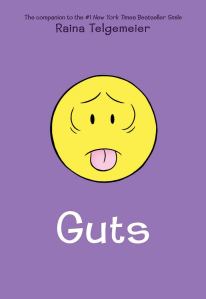 Raina Telgemeier is extremely popular among grade school girls; it’s a big deal when she comes out with a new graphic novel. This is her fifth one (besides the graphic novel adaptations of the Baby-Sitters Club books and the book Share Your Smile, which is essentially a journal with writing prompts) and it’s her third autobiographical graphic novel with the iconic yellow face on the cover. The first two were about the author’s orthodontic experiences and her relationship with her sister. This time, she tells the story of a mysterious illness that turns out to be a symptom of anxiety. After recovering from a stomach bug, Raina developed a fear of throwing up, being around people who are sick, or eating certain foods like artichokes. Over the course of the book, she gradually realizes that her problems are more emotional than physical and learns to overcome them. This one is actually very similar to Best Friends, which I listed above. I decided to include them both because I wasn’t able to decide which I liked better.
Raina Telgemeier is extremely popular among grade school girls; it’s a big deal when she comes out with a new graphic novel. This is her fifth one (besides the graphic novel adaptations of the Baby-Sitters Club books and the book Share Your Smile, which is essentially a journal with writing prompts) and it’s her third autobiographical graphic novel with the iconic yellow face on the cover. The first two were about the author’s orthodontic experiences and her relationship with her sister. This time, she tells the story of a mysterious illness that turns out to be a symptom of anxiety. After recovering from a stomach bug, Raina developed a fear of throwing up, being around people who are sick, or eating certain foods like artichokes. Over the course of the book, she gradually realizes that her problems are more emotional than physical and learns to overcome them. This one is actually very similar to Best Friends, which I listed above. I decided to include them both because I wasn’t able to decide which I liked better.
Middle Grade Novels:
The Next Great Paulie Fink by Ali Benjamin
When Caitlyn Breen starts seventh grade at her new school, her classmates are quick to regale her with tales of the exploits and antics of Paulie Fink. He had been in their class until he mysteriously vanished over the summer. His eccentricities were so important to the students that they decide they need to appoint someone to fill his role. Thus begins a reality-TV-style competition with Caitlyn as the judge. This novel puts a new spin on the common “new kid in school” trope by combining it with motifs about reputation, labels, and to some extent, the question of how self-identity relates to those things. Ali Benjamin skillfully weaves the characters’ school curriculum into the plot; the children frequently use their newly-learned terms and ideas in their out-of-the-classroom conversations. The result is that this book is thought-provoking and intellectual without seeming too academic to be fun. Most of Caitlyn’s classmates and teachers (as well as her mother) are complex and well-developed characters, and Caitlyn herself experiences notable character development. She gradually comes to the realization that she was becoming the stereotypical “mean girl” at her old school, but she overcomes that by bonding with her new classmates and coming to appreciate their eccentricities.
The Remarkable Journey of Coyote Sunrise by Dan Gemeinhart
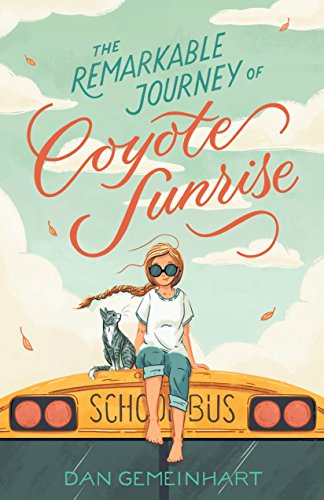 This was the first 2019 middle grade novel that I read, and I never did find anything that topped it. This book has it all: a quirky main character with a sad backstory and a distinctive narrative voice, a diverse cast of well-developed secondary characters, an important mission that has to be achieved on a very tight timeline, family secrets that are revealed very gradually, and a cute kitten. Coyote and her father Rodeo live in an old repurposed school bus that they drive all around the country, never stopping anywhere for very long. As we later realize, this is because Rodeo can’t come to terms with the deaths of Coyote’s mother and sisters. He is deliberately avoiding any semblance of normalcy that reminds him of his old home and family life. Although Coyote is lonely, she’s relatively content with their eccentric nomadic lifestyle until she hears from her grandmother that the park in her hometown is going to be demolished. Unbeknownst to anyone else, Coyote and her mother and sisters wrote letters to each other and buried them in that park shortly before the tragedy. Now Coyote is on a mission to get back home before the park is demolished, but she has to do so without letting her father know what she’s planning. She knows that he doesn’t want to dig up the past, either literally or metaphorically, so she has to come up with other reasons to travel in that direction. Along the way, Coyote and Rodeo pick up a number of other characters who are all on various different journeys. Amidst the constant, fast-paced action, there are lots of poignant and bittersweet moments and lots of meaningful points about friendship, family, grief, and the importance of having a home.
This was the first 2019 middle grade novel that I read, and I never did find anything that topped it. This book has it all: a quirky main character with a sad backstory and a distinctive narrative voice, a diverse cast of well-developed secondary characters, an important mission that has to be achieved on a very tight timeline, family secrets that are revealed very gradually, and a cute kitten. Coyote and her father Rodeo live in an old repurposed school bus that they drive all around the country, never stopping anywhere for very long. As we later realize, this is because Rodeo can’t come to terms with the deaths of Coyote’s mother and sisters. He is deliberately avoiding any semblance of normalcy that reminds him of his old home and family life. Although Coyote is lonely, she’s relatively content with their eccentric nomadic lifestyle until she hears from her grandmother that the park in her hometown is going to be demolished. Unbeknownst to anyone else, Coyote and her mother and sisters wrote letters to each other and buried them in that park shortly before the tragedy. Now Coyote is on a mission to get back home before the park is demolished, but she has to do so without letting her father know what she’s planning. She knows that he doesn’t want to dig up the past, either literally or metaphorically, so she has to come up with other reasons to travel in that direction. Along the way, Coyote and Rodeo pick up a number of other characters who are all on various different journeys. Amidst the constant, fast-paced action, there are lots of poignant and bittersweet moments and lots of meaningful points about friendship, family, grief, and the importance of having a home.
Eventown by Corey Ann Haydu
Eleven-year-old Elodee, her twin sister Naomi, and their parents are moving away from their hometown of Juniper so that they can start a new life in idyllic Eventown. They’ve had a really hard time lately, and this new start seems like the only thing that can make things right. We aren’t told the details of their tragedy until near the end of the book, but there are enough hints that it’s fairly evident that there was a teenage brother who died a few months ago. The family begins to regain their happiness as soon as they arrive at their new home, and Naomi especially is comfortable and content. But something seems wrong to Elodee. The town lives up to its name; everything is completely even and uniform and perfect. Vanilla cake is the only acceptable flavor here, there’s only one song in town, all of the library books are blank, and the gymnasts on Naomi’s new team each do the exact same routine. Elodee misses being creative in the kitchen, listening to Beatles music, and watching her sister work hard to perfect new gymnastics moves. Elodee and Naomi eventually find out that all newcomers to Eventown are required to give away six stories from their past. Once told, these stories are forgotten, and the person’s past experiences no longer impact their current life. That’s why Eventown is the perfect opportunity to make a fresh start, and it’s also what makes everything so “even”. But Elodee is interrupted and doesn’t get to finish telling her stories. She loses a lot of her memories, including those that involve her brother, but she retains traits such as her creativity. The setting is so reminiscent of Camazotz in A Wrinkle in Time that this whole book felt like a homage to that one. (Although to be fair, I know that the “perfect” yet dystopian town is a relatively common motif, so it’s entirely possible that the author wasn’t deliberately alluding to any specific story) Yet there are obvious differences, most significantly in the history and purpose of the town. And Haydu uses the premise to make specific points not only about individuality and creativity, but also about grief, love, and the importance of personal memories.
Shouting at the Rain by Lynda Mullaly Hunt
Delsie had never really thought of herself as an orphan until her friend Aimee brings it up. But she has been wishing that she knew more about her parents and her own past. It’s sad knowing that she was abandoned by her own mother, even though she has her loving grandmother and neighbors who act as parent figures in some ways. Delsie is also upset that things have changed between her and her friend Brandy. Delsie lives at Cape Cod year-round, but Brandy is only there in the summer, and she’s grown up a lot since last summer. She suddenly cares more about working on her tan and getting her nails done than collecting stones and rocks. And then Brandy makes a new friend, leaving Delsie feeling left out and unliked. But Delsie also finds a new friend in Ronan, an angry boy who initially seems like a troublemaker. As they get to know each other better, Delsie realizes that Ronan is actually brave, loyal, and desperately in need of a friend. Over the course of the book, Delsie gradually learns the answers to some of her questions about her mother. Throughout the story, weather is a recurring motif, both in the actual plot and in metaphors about the “storms” that people face in their lives.
Song for a Whale by Lynne Kelly
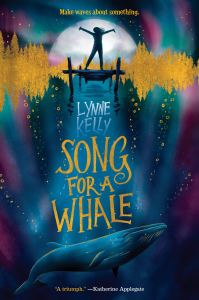 It might seem a little strange that a deaf person would be fascinated by radios, but twelve-year-old Iris is quite the expert at repairing them. She is so knowledgeable and perceptive that she can rely on vibrations to tell when she’s succeeded at fixing them. One day, Iris’s teacher tells the class about a whale (whom marine biologists have named “Blue 55”) that can’t communicate with other whales because his whale song is at a completely different pitch. Iris relates to this dilemma because of the isolation that her deafness causes, and she feels an urge to help this whale by finding a way to communicate with him. She emails Andi, a marine biologist who is trying to track the whale, and suggests using underwater speakers to play sounds at Blue 55’s pitch back at him. In fact, she does some research, seeks out assistance from the music teacher, and uses her technology skills to make the audio files herself. The researchers are interested in Iris’s idea, but she later finds out that they aren’t planning to follow through. This is unacceptable, so Iris run away from home to find the whale and play the whale song for him. What began as a realistic story turns into a wild and exciting adventure, eventually reaching a climactic (and unrealistic) scene in which Iris jumps into the water and meets Blue 55 face to face. Ultimately, it’s a feel-good story about a strong-willed girl whose limitations are no match for her determination, intelligence, and passion.
It might seem a little strange that a deaf person would be fascinated by radios, but twelve-year-old Iris is quite the expert at repairing them. She is so knowledgeable and perceptive that she can rely on vibrations to tell when she’s succeeded at fixing them. One day, Iris’s teacher tells the class about a whale (whom marine biologists have named “Blue 55”) that can’t communicate with other whales because his whale song is at a completely different pitch. Iris relates to this dilemma because of the isolation that her deafness causes, and she feels an urge to help this whale by finding a way to communicate with him. She emails Andi, a marine biologist who is trying to track the whale, and suggests using underwater speakers to play sounds at Blue 55’s pitch back at him. In fact, she does some research, seeks out assistance from the music teacher, and uses her technology skills to make the audio files herself. The researchers are interested in Iris’s idea, but she later finds out that they aren’t planning to follow through. This is unacceptable, so Iris run away from home to find the whale and play the whale song for him. What began as a realistic story turns into a wild and exciting adventure, eventually reaching a climactic (and unrealistic) scene in which Iris jumps into the water and meets Blue 55 face to face. Ultimately, it’s a feel-good story about a strong-willed girl whose limitations are no match for her determination, intelligence, and passion.
A Sprinkle of Spirits by Anna Meriano
This is the second book in the Love, Sugar, Magic series about a family-owned bakery that uses magic to make its goods extra special. Eleven-year-old Leonora (Leo for short) was initiated into the family secret a few years early after the events of the first book. By the beginning of this one, she is studying magic in earnest, but there’s a lot to learn. Leo feels she’s being asked to choose between her family and her friend Caroline. One morning, the spirit of Leo’s Abuela suddenly shows up in her bedroom. It turns out that she’s not the only one. Other spirits have suddenly popped up all over town, and they all have things they want to do or people they want to talk to. This is unacceptable; they’re going to scare people and give away secrets. It’s up to Leo to stop them. Along the way, she joins forces with several of her friends, some of whom didn’t know yet about the magic in Leo’s family. What follows is a comical adventure in which Leo and her sisters and friends run around town trying to round up a bunch of ornery and mischievous ghosts. But despite the humor, there are sad moments, too. One of Leo’s friends, Tricia, has just found out that her father is secretly ill, possibly dying, and Leo’s best friend Caroline lost her mother relatively recently. In fact, (spoiler alert!) it turns out that Caroline had been trying to reach her deceased mother, which is what brought the spirits in the first place. But despite all the mentions of death, this book is overall a light-hearted and funny story about family, friendship, magic, and the realization that it really is possible to have all of those things.
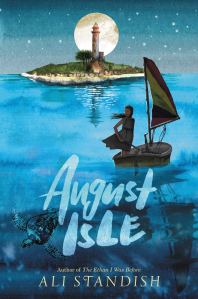 Miranda is being sent to stay with her mother’s childhood friend in the small Florida vacation town of August Isle. She’d actually always wanted to visit August Isle, but she didn’t want it to be like this; she feels abandoned and unloved when her mom goes on work trips. Miranda decides that she wants to use this opportunity to learn more about her mother’s childhood. At one point, she and two new friends investigate a local legend by sneaking into a house that they think is abandoned. But the house’s owner has just returned, and he catches them. Instead of calling the police or the children’s parents, he demands that they help him organize the things he’s brought back from his travels. He ends up being a source of fascinating stories and valuable life lessons. Meanwhile, Miranda does gradually learn more about her mother’s story, including a dark family secret that explains the emotional disconnect she’s felt for years. The summertime vacation-y setting and the air of mystery is a common combination for middle grade novels, but this particular book stands out as an especially good such story because of Miranda’s mature and introspective narrative voice and because of the book’s insightful messages about the different ways in which people cope with tragedy and the importance of acknowledging the past.
Miranda is being sent to stay with her mother’s childhood friend in the small Florida vacation town of August Isle. She’d actually always wanted to visit August Isle, but she didn’t want it to be like this; she feels abandoned and unloved when her mom goes on work trips. Miranda decides that she wants to use this opportunity to learn more about her mother’s childhood. At one point, she and two new friends investigate a local legend by sneaking into a house that they think is abandoned. But the house’s owner has just returned, and he catches them. Instead of calling the police or the children’s parents, he demands that they help him organize the things he’s brought back from his travels. He ends up being a source of fascinating stories and valuable life lessons. Meanwhile, Miranda does gradually learn more about her mother’s story, including a dark family secret that explains the emotional disconnect she’s felt for years. The summertime vacation-y setting and the air of mystery is a common combination for middle grade novels, but this particular book stands out as an especially good such story because of Miranda’s mature and introspective narrative voice and because of the book’s insightful messages about the different ways in which people cope with tragedy and the importance of acknowledging the past.
Other middle grade novels:
The Friendship War by Andrew Clements
Spark by Sarah Beth Durst
Sal & Gabi Break the Universe by Carlos Hernandez
The Unteachables by Gordon Korman
Over the Moon by Natalie Lloyd
Pay Attention, Carter Jones by Gary D. Schmidt
The Bridge Home by Padma Venkatraman
Poetry/verse:
Clackety Track: Poems About Trains by Skila Brown, illustrated by Jamey Christoph
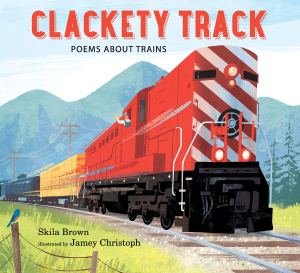 When this book came out back in the spring, I was a little indecisive about where it belonged at my library. As the subtitle indicates, it’s technically a book of poetry, which would put it in the 811 section of the nonfiction collection. But most of those books don’t get checked out very often. It’s also technically a picture book, and a particularly pretty one at that. But it has a lot more text than most picture books, plus lots of nonfiction information about trains. So we ended up putting it in the nonfiction section with a 625 call number. (That’s the trains section within the transportation section within the technology section) For this list, though, I’m classifying it as a book of poetry. That’s because, instead of trying to figure out where library patrons are most likely to be looking if they’re interested in this type of book, now I’m just trying to identify the aspects that make it so appealing and distinctive. In my opinion, the answer is the literary quality of the poems themselves. The language is descriptive and generally sticks to a meter and rhyme scheme, and each poem is laid out on the page in a format that somehow seems fitting for the topic of the poem. For example, the poem “Tracks” has very short lines that are printed diagonally, lining up with the individual railroad ties in the picture. There are lots of beautiful picture books about trains, and there are lots of very informative nonfiction books about trains, but there aren’t so many poetry books that also happen to be as visually appealing and informative as this book.
When this book came out back in the spring, I was a little indecisive about where it belonged at my library. As the subtitle indicates, it’s technically a book of poetry, which would put it in the 811 section of the nonfiction collection. But most of those books don’t get checked out very often. It’s also technically a picture book, and a particularly pretty one at that. But it has a lot more text than most picture books, plus lots of nonfiction information about trains. So we ended up putting it in the nonfiction section with a 625 call number. (That’s the trains section within the transportation section within the technology section) For this list, though, I’m classifying it as a book of poetry. That’s because, instead of trying to figure out where library patrons are most likely to be looking if they’re interested in this type of book, now I’m just trying to identify the aspects that make it so appealing and distinctive. In my opinion, the answer is the literary quality of the poems themselves. The language is descriptive and generally sticks to a meter and rhyme scheme, and each poem is laid out on the page in a format that somehow seems fitting for the topic of the poem. For example, the poem “Tracks” has very short lines that are printed diagonally, lining up with the individual railroad ties in the picture. There are lots of beautiful picture books about trains, and there are lots of very informative nonfiction books about trains, but there aren’t so many poetry books that also happen to be as visually appealing and informative as this book.
A Song for Gwendolyn Brooks by Alice Faye Duncan, illustrated by Xia Gordon
This is another book that is simultaneously a picture book, nonfiction, and poetry. If I had to pick favorite, I’d rank it somewhat below Clackety Track, but it hits some of the same appeal factors. And it’s only fitting for a picture book biography about a poet to be written in verse. It includes a few of Brooks’ own poems, which is a nice touch. I appreciated the way that Brooks’ work and her personal story are laid out side by side. The book puts a lot of its focus on Gwendolyn Brooks’ childhood and teenage years, but it tells her story up to the point of her Pulitzer prize in 1950 (she was just short of 33 at the time) and then adds further information in an author’s note and timeline at the end of the book.
Emmy in the Key of Code by Aimee Lucido
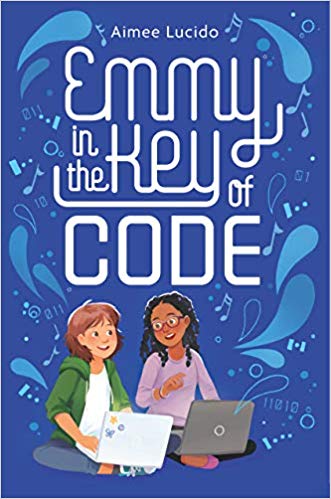 Probably the most important criterion that I look for when reading a novel in verse is that there should be a reason for the verse format. It should express things better than it could if it was written in prose. (Public service announcement: “prose” does not mean poetry. It’s the opposite. Prose is the term for regular, non-metrical written language. Please don’t say that something is “written in prose” if you mean “written in verse”.) That’s definitely the case here because a lot of the “poems” are actually written in such a way that they look like javascript. This novel in verse doesn’t just tell a story while sounding poetic, it also directly demonstrates the logic of javascript. It’s fascinating just how effective that format is for describing Emmy’s experiences, feelings, and internal conflicts. The syntax for things like variables, strings, loops, conditionals can be used to describe patterns in everyday life or to list the factors involved in making a decision. The fact that this kind of “poem” even works illustrates a fascinating connection between everyday language and technical semantics, between art and technology, and between creativity and logic. Music also plays a large role in the story, and there’s a strongly implied connection between music and coding. This is the kind of book that introduces kids to new ideas and even new hobbies, and that’s always a good thing for a book to do.
Probably the most important criterion that I look for when reading a novel in verse is that there should be a reason for the verse format. It should express things better than it could if it was written in prose. (Public service announcement: “prose” does not mean poetry. It’s the opposite. Prose is the term for regular, non-metrical written language. Please don’t say that something is “written in prose” if you mean “written in verse”.) That’s definitely the case here because a lot of the “poems” are actually written in such a way that they look like javascript. This novel in verse doesn’t just tell a story while sounding poetic, it also directly demonstrates the logic of javascript. It’s fascinating just how effective that format is for describing Emmy’s experiences, feelings, and internal conflicts. The syntax for things like variables, strings, loops, conditionals can be used to describe patterns in everyday life or to list the factors involved in making a decision. The fact that this kind of “poem” even works illustrates a fascinating connection between everyday language and technical semantics, between art and technology, and between creativity and logic. Music also plays a large role in the story, and there’s a strongly implied connection between music and coding. This is the kind of book that introduces kids to new ideas and even new hobbies, and that’s always a good thing for a book to do.
YA Novels:
The Missing Piece of Charlie O’Reilly by Rebecca K. Ansari
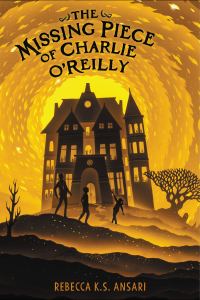 This book falls on the line between middle grade and YA; it’s probably best for middle-school-aged readers. It’s a complex adventure story that starts in a realistic setting but has fantasy elements and ghost-story vibes. Charlie O’Reilly is the only one who remembers his younger brother Liam, who suddenly disappeared a year ago. He’s learned to stop talking about Liam because his friend Ana is the only one who believes him, and his parents have been making him see a child psychiatrist. Secretly, Charlie has been trying to solve this mystery all year, but now he’s finally experiencing some odd things that seem to be clues, such as finding his comic books rearranged, and having vivid dreams in which he is a boy named Kieran living during the Irish potato famine. Ana is skeptical that these things have any significance, but she loyally goes along with his investigation, which leads him to seek help from a teenage boy who he knows from baseball practice. What follows is a bizarre adventure into an otherworldly orphan asylum populated by children who have been forgotten by the outside world because they had at some point wished they didn’t exist. Like many of the other books on this list, this novel has lots of twists and turns that gradually reveal a dark but satisfying backstory.
This book falls on the line between middle grade and YA; it’s probably best for middle-school-aged readers. It’s a complex adventure story that starts in a realistic setting but has fantasy elements and ghost-story vibes. Charlie O’Reilly is the only one who remembers his younger brother Liam, who suddenly disappeared a year ago. He’s learned to stop talking about Liam because his friend Ana is the only one who believes him, and his parents have been making him see a child psychiatrist. Secretly, Charlie has been trying to solve this mystery all year, but now he’s finally experiencing some odd things that seem to be clues, such as finding his comic books rearranged, and having vivid dreams in which he is a boy named Kieran living during the Irish potato famine. Ana is skeptical that these things have any significance, but she loyally goes along with his investigation, which leads him to seek help from a teenage boy who he knows from baseball practice. What follows is a bizarre adventure into an otherworldly orphan asylum populated by children who have been forgotten by the outside world because they had at some point wished they didn’t exist. Like many of the other books on this list, this novel has lots of twists and turns that gradually reveal a dark but satisfying backstory.
Patron Saints of Nothing by Randy Ribay
The link above goes to my earlier post about the finalists for the National Book Awards, because this book made the shortlist. It’s a contemporary realistic-fiction, coming-of-age story about a Filipino American teenage boy who suddenly finds out about the political unrest and violence in his homeland when his cousin is killed in the Philippines’ bloody war on drugs. Jay and his cousin Jun had at one time been close, but they lost touch years ago. Jay is determined to uncover the truth behind his cousin’s death and travels to the Philippines. Subplots include conflicts with his authoritarian uncle and hints of a developing romance with a journalism student who helps him in his search for the truth. In the interest of time and space, I’ve deleted my comments on the political messages of the book. Suffice to say, this book has a lot to say about current events in the Philippines, and I’m not well enough informed to evaluate the book’s objectivity. (Or even its accuracy) But I’ve decided to include it on this list because it’s an interesting story with some degree of mystery and suspense, and it encourages the reader to take an interest in what’s going on in other parts of the world.
Thirteen Doorways, Wolves Behind Them All by Laura Ruby
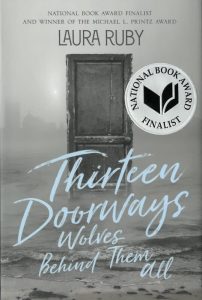 This was another National Book Award finalist, but at the time that I wrote the blog post linked above, I had barely started reading the book and didn’t have anything to say about it other than to comment on the genre and writing style. I can now add that it’s very interesting and I loved it. It’s told from the perspective of a ghost, but the main character is an alive teenage girl named Frankie (short for Francesca) in an orphanage in Chicago at the time of World War II. She technically isn’t an orphan, but her father and stepmother have decided that they aren’t able to support Frankie and her brother and sister. At first, the ghost narrator focuses so much on Frankie’s life that it’s easy for the reader to briefly forget that this isn’t a third-person narrative; there is a specific character telling the story. But later, the ghost (who eventually reveals that her name is Pearl) begins to spend more time away from the orphanage, usually with another ghost named Marguerite and a fox she calls Wolf. Pearl becomes interested in Marguerite’s tragic backstory in which she is murdered by the woman who ends up marrying her lover. It is slowly revealed that Pearl also has a tragic love story, although many of the details aren’t revealed until the end. Meanwhile, Frankie falls in love with a boy named Sam, and her experiences mirror Pearl’s history in many ways. By the end of the book, Frankie and Pearl are essentially taking turns being the focal point of the story. An author’s note at the end of the book reveals that Frankie’s experiences are based on those of the author’s mother-in-law and that this book was a labor of love that took well over a decade to write. That doesn’t surprise me; this book is an incredibly detailed masterpiece in which every word feels deliberate and purposeful.
This was another National Book Award finalist, but at the time that I wrote the blog post linked above, I had barely started reading the book and didn’t have anything to say about it other than to comment on the genre and writing style. I can now add that it’s very interesting and I loved it. It’s told from the perspective of a ghost, but the main character is an alive teenage girl named Frankie (short for Francesca) in an orphanage in Chicago at the time of World War II. She technically isn’t an orphan, but her father and stepmother have decided that they aren’t able to support Frankie and her brother and sister. At first, the ghost narrator focuses so much on Frankie’s life that it’s easy for the reader to briefly forget that this isn’t a third-person narrative; there is a specific character telling the story. But later, the ghost (who eventually reveals that her name is Pearl) begins to spend more time away from the orphanage, usually with another ghost named Marguerite and a fox she calls Wolf. Pearl becomes interested in Marguerite’s tragic backstory in which she is murdered by the woman who ends up marrying her lover. It is slowly revealed that Pearl also has a tragic love story, although many of the details aren’t revealed until the end. Meanwhile, Frankie falls in love with a boy named Sam, and her experiences mirror Pearl’s history in many ways. By the end of the book, Frankie and Pearl are essentially taking turns being the focal point of the story. An author’s note at the end of the book reveals that Frankie’s experiences are based on those of the author’s mother-in-law and that this book was a labor of love that took well over a decade to write. That doesn’t surprise me; this book is an incredibly detailed masterpiece in which every word feels deliberate and purposeful.
Genesis Begins Again by Alicia D. Williams
This is another one that stands on the line between middle grade and YA. It describes a thirteen-year-old girl’s struggles with self-image, poverty, and tensions within her family. In her mind, a lot of her problems are related to her skin color. She has very dark skin like her father, instead of a lighter brown skin tone like her mother’s side of the family. Genesis’ maternal grandmother later tells Genesis that everyone in their family is supposed to “marry up” in hopes of producing children with a lighter shade of skin. Genesis’ mother, for all of her beauty and brains, is something of a rebel for marrying a man with such dark skin. Throughout the book, Genesis experiments with various strategies for changing her skin color. Meanwhile, her family has moved into a much nicer neighborhood than anywhere they’ve lived before, and Genesis likes her new school and finds a positive mentor in her new music teacher. She is even starting to discover new interests and talents, mainly in regards to music. But then she finds out that her family is at risk of being evicted again and that she is likely to lose everything. The book ends on an optimistic note. Many of the problems that Genesis and her family face are not exactly solved, but various issues have been addressed and there’s a sense that they’ll figure everything out eventually.
Nonfiction:
The Important Thing About Margaret Wise Brown by Mac Barnett, illustrated by Sarah Jacoby
This picture book biography is 42 pages long, a fact which it points out on page 1. “You can’t fit somebody’s life into 42 pages,” it tells the reader, “so I am just going to tell you some important things.” What follows is a conversational, stream-of-conscious collection of anecdotes about children’s author Margaret Wise Brown, with lots of first-person and second-person pronouns, opinions, and questions addressed to the reader. Basically, this book defies the rules of nonfiction. But in so doing, it mimics Brown’s own writing style. It’s clever and in many ways, more informative and thought-provoking than a traditional biography. The reader is encouraged to consider questions about what constitutes an “important” thing about a person, about whether “strange” is necessarily bad, and about what kinds of things belong in children’s books. (It comes down pretty harshly on Anne Carroll Moore, a pioneer in library services for children and children’s literature. She did a lot of very positive things, but unfortunately, she had no qualms about censoring books that she thought were inappropriate, even if it was only because they struck her as being silly. She was not a fan of Margaret Wise Brown and especially disliked Goodnight Moon.) Both at the beginning and at the end of this book, Barnett simply informs readers that the important thing about Margaret Wise Brown was that she wrote books.
The Who Was? History of The World by Paula K. Manzanero
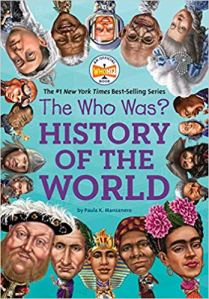 I recommend using this essentially as a reference book; it’s sort of an index to the Who Was? series, even though it’s written in regular paragraph format. It’s is a very concise summary of world history with a timeline that points out the birth years of 150 famous people who are included in this popular biography series. If this was a standalone book, it would be a little too brief and superficial to be especially informative, especially since it dedicates most of its pages to the past two and a half centuries. But as a companion book to the biography series, it serves the purpose of putting all of these noteworthy people into their historical context. Considering that the target audience is children in elementary school, that’s a pretty ambitious but very important task. History is usually presented to children as a list of facts and figures, often organized by place instead of by time period, so most children have a hard time figuring out the sequence of historical events. This book puts that information in order nicely and neatly. For the reader who wants more than an overview, the other Who Was? books will flesh out the details that this book leaves out or mentions only briefly.
I recommend using this essentially as a reference book; it’s sort of an index to the Who Was? series, even though it’s written in regular paragraph format. It’s is a very concise summary of world history with a timeline that points out the birth years of 150 famous people who are included in this popular biography series. If this was a standalone book, it would be a little too brief and superficial to be especially informative, especially since it dedicates most of its pages to the past two and a half centuries. But as a companion book to the biography series, it serves the purpose of putting all of these noteworthy people into their historical context. Considering that the target audience is children in elementary school, that’s a pretty ambitious but very important task. History is usually presented to children as a list of facts and figures, often organized by place instead of by time period, so most children have a hard time figuring out the sequence of historical events. This book puts that information in order nicely and neatly. For the reader who wants more than an overview, the other Who Was? books will flesh out the details that this book leaves out or mentions only briefly.
How to Be a Coder by Kiki Prottsman
There are lots of kids’ coding books coming out all the time, but this one stands out as being especially child-friendly and beginner-oriented while still giving readers the information they need to get started doing some coding themselves. It accomplishes this simply by presenting the information in the right order. The first half of the book doesn’t involve computer software at all. It presents computer-related concepts and introduces terminology by using them in non-computerized crafts and games. For example, pixels are described by a craft that involves gluing small squares of paper onto a grid to form a picture, conditionals are illustrated by a simple guessing game, and decomposition is taught by building a cardboard castle. (The instructions are simple once you recognize that this is a project that can be divided into several parts) Other activities involve origami, paper chains, making up a dance, and baking. Only after all of this does the book send its reader to a computer. Instead of being confused and overwhelmed by technical terms, readers will recognize the concepts from the first section. The terminology and images in this book are all from Scratch 3.0, a popular and kid-friendly coding language specific to this website, but it can easily be applied to any similar coding programs. Mixed in with all of this, there is also historical information about the development of computers and biographical information about pioneers in computer science.
1919: The Year that Changed America by Martin W. Sandler
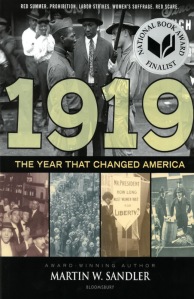 This book won the National Book Award in the Young People’s Literature category. But even though it was marketed (and awarded) as a YA nonfiction book, I think it could absolutely be considered a book for grown-ups, too. Certainly, most adult readers will find facts they didn’t know by reading it. I love the very concept of this book. It zooms in on one particular year in history and examines the causes and effects of some of that year’s newsworthy events. In my opinion, every year is eventful enough that there’d be plenty of material for such a book, but 1919 was an especially pivotal year in a number of ways. There were landmark events regarding issues such as women’s suffrage, race relations, labor laws, and prohibition, not to mention the fact that World War I had just ended and the industrial revolution was relatively recent history. These topics are all included in this book, with detailed discussion of the context. There are lots of photographs, which keeps the book visually appealing and further contributing to the context. Each chapter includes a timeline of relevant events, most of which extend well beyond and well before 1919. There also is a “One Hundred Years Later” section at the end of each chapter. In some cases, those sections express political opinions about current events, which I initially felt was a drawback to this book, but in retrospect, it does serve a purpose. Readers who don’t agree with the author’s opinions can still appreciate the parallels and the contrast between different time periods, and teen readers can benefit from taking a moment to think about the ways in which history does or doesn’t support their own political views.
This book won the National Book Award in the Young People’s Literature category. But even though it was marketed (and awarded) as a YA nonfiction book, I think it could absolutely be considered a book for grown-ups, too. Certainly, most adult readers will find facts they didn’t know by reading it. I love the very concept of this book. It zooms in on one particular year in history and examines the causes and effects of some of that year’s newsworthy events. In my opinion, every year is eventful enough that there’d be plenty of material for such a book, but 1919 was an especially pivotal year in a number of ways. There were landmark events regarding issues such as women’s suffrage, race relations, labor laws, and prohibition, not to mention the fact that World War I had just ended and the industrial revolution was relatively recent history. These topics are all included in this book, with detailed discussion of the context. There are lots of photographs, which keeps the book visually appealing and further contributing to the context. Each chapter includes a timeline of relevant events, most of which extend well beyond and well before 1919. There also is a “One Hundred Years Later” section at the end of each chapter. In some cases, those sections express political opinions about current events, which I initially felt was a drawback to this book, but in retrospect, it does serve a purpose. Readers who don’t agree with the author’s opinions can still appreciate the parallels and the contrast between different time periods, and teen readers can benefit from taking a moment to think about the ways in which history does or doesn’t support their own political views.
Manhattan: Mapping the Story of an Island by Jennifer Thermes
This is another history book with a very limited scope, but this time, that scope is a place rather than a time. It follows the island of Manhattan from the time when it was inhabited by the Lenape people to the current day, with information about European settlers, New York’s role in the Revolutionary War, and its rapid development during the 19th century. (Interestingly enough, the book glazes over the twentieth and early twenty-first century.) There are also fun facts about Central Park, illustrated lists of the most famous bridges and skyscrapers in Manhattan, and lots of detailed maps at various points in history. Those maps are the most interesting thing about this book. Children and adults alike could spend lots of time looking at those maps, reading the names of the buildings and streets, and comparing maps from different parts of the book to follow the island’s development. Make sure to look at the endpapers, too! (That is, the inside of the covers) They have a detailed map of Manhattan with notes pointing out twenty-five interesting historical landmarks. For all of its historical and geographic information, the book is a relatively quick read and it’s written at (more or less) a second-grade reading level. The brightly-colored, somewhat cartoonish artwork could actually appeal to kids even younger than that.